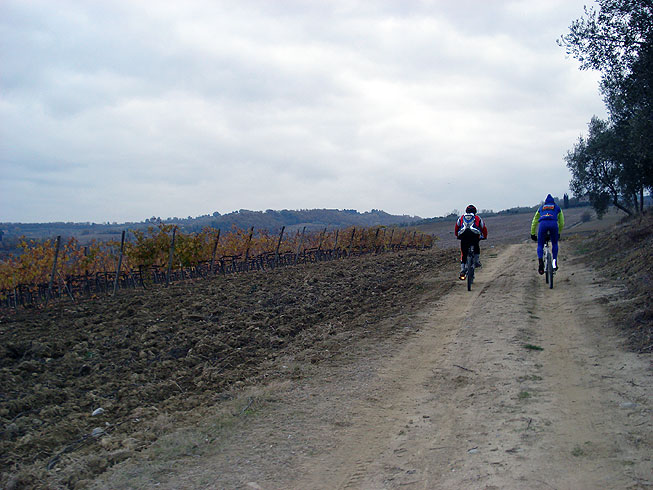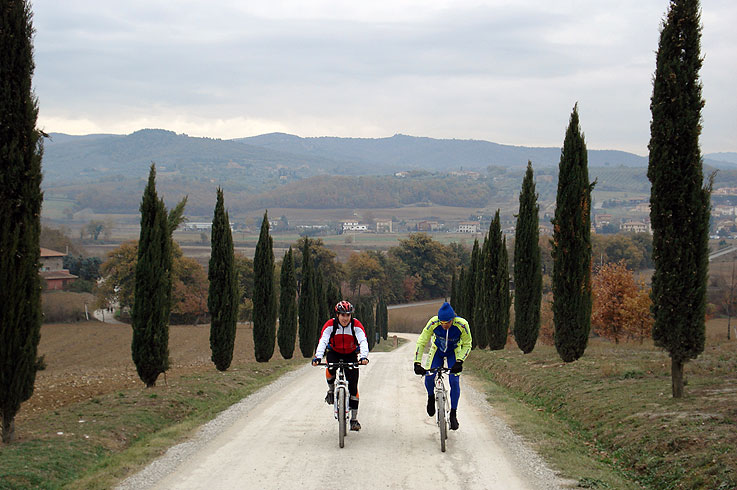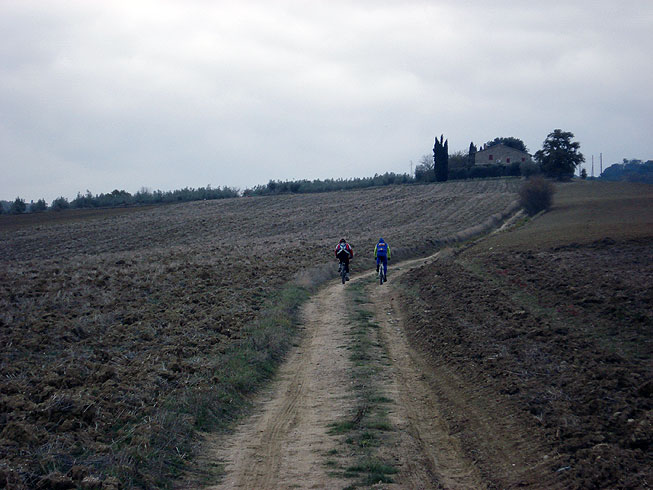| Partenza | Paciano |
| Arrivo | Paciano |
| Distanza | 33 km |
| Dislivello | 850 m |
| Difficoltà | difficile |
| Fondo | 70% sterrato, 30% asfalto |
| Bici consigliata | MTB, E-MTB |
| Da vedere in zona | Paciano, Città della Pieve, Panicale, Monte Pausillo. |
Il chilometraggio e il dislivello ne fanno un itinerario da classificare tra quelli medio-difficili. La partenza è fissata dal centro di Panicale, in Piazza della Repubblica, da dove si inizia a scendere verso valle. Lasciato l'asfalto si imbocca lo sterrato che, superati i sottopassaggi della ferrovia e della statale, riporta alla strada asfaltata ai piedi di Villastrada.
Proseguite diritti affrontando un breve strappo sterrato. Poi, dopo una veloce discesa, incrociando la SS 71 al chilometro 11,1, svoltate a destra in direzione di Chiusi. Subito dopo, lasciando la statale al km 11,4, svoltate a sinistra iniziando la prima salita del percorso: uno splendido sterrato che si sviluppa dapprima in mezzo al bosco, poi tra vitigni e campi coltivati fino a San Litardo dove, immettendosi sulla SS 71 Nord, si continua a salire verso Città della Pieve.
Al chilometro 18,5 arrivate a Città della Pieve, centro di origine etrusco-romana, dove potete fermarvi per una visita. Ripartite in direzione del campo sportivo e una volta terminato l'asfalto proseguite in discesa su di uno sterrato piuttosto sconnesso. Terminata la discesa pedalate per alcuni chilometri all'interno di una stretta valle fino a quando non incrociate la SP309 (km 24), da attraversare imboccando lo sterrato dalla parte opposta. In questo punto inizia la seconda e più impegnativa salita del percorso.
Molto ripidi e sassosi, i primi 200 metri possono costringere a mettere piede a terra; il prosieguo della salita invece risulta meno impervio. Si pedala per diversi chilometri immersi nel bosco e poi, avvicinandosi alla cima, la visuale si apre e permette di ammirare scenari mozzafiato in cui, nelle giornate più limpide, è possibile distinguere anche l'Abetone. La salita si conclude a pochi metri dalla vetta del Monte Pausillo (km 29,5). Da qui inizia la discesa verso Paciano: un tratto tecnico da percorrere con particolare attenzione.
Dopo i primi metri, svoltate a destra e risalendo brevemente, imboccate a sinistra lo stretto single track all'interno della pineta. Appena fuori dalla pineta, svoltate a sinistra e riprendete lo sterrato principale che in pochi chilometri vi riconduce fino al centro di Paciano.
Lungo il percorso, godetevi il potere rigenerante dei boschi del Monte Pausillo, approfittando dei panorami stupendi che si aprono sul lago Trasimeno e su tutte le valli circostanti, con una visuale che arriva fino al Monte Amiata e che, nelle giornate più limpide, abbraccia anche l'Abetone. Meritano una visita anche i borghi attraversati dall’itinerario. Il centro storico di Paciano, ad esempio, è tra i Borghi più Belli d'Italia per il notevole patrimonio ambientale ed artistico, è racchiuso in una cinta muraria trecentesca con torri e tre porte d'ingresso e si erge in un territorio ricco di boschi di lecci, querce e castagni. Il borgo medievale di Panicale è invece adagiato sulle colline del lago Trasimeno da dove si può godere di splendide vedute sul panorama lacustre e sulla valle del Nestore. All'interno del paese degni di nota sono il Palazzo del Popolo, la Collegiata di San Michele, il complesso di San Sebastiano e il Teatro Cesare Caporali. Imperdibile Città della Pieve: antico centro etrusco-romano, ha mantenuto intatta gran parte della sua struttura antica. Tra gli edifici di maggior pregio ci sono il Duomo, che conserva le opere di due grandi pittori, il Perugino ed il Pomarancio; la chiesa di Santa Maria dei Bianchi, dove si trova la straordinaria Adorazione dei Magi del Perugino; la Rocca (1326), con cinque torri; il palazzo della Corgna (XVI secolo); palazzo Bandini (XVI secolo); palazzo della Fargna (XVIII secolo), sede del Comune, e palazzo Baglioni, del XVIII secolo.





















.jpg/ccb33cc7-ccc5-8b2b-1ed4-deda6003f4f3?width=456)







